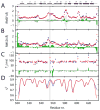Mutation in transforming growth factor beta induced protein associated with granular corneal dystrophy type 1 reduces the proteolytic susceptibility through local structural stabilization
- PMID: 24129074
- PMCID: PMC4162128
- DOI: 10.1016/j.bbapap.2013.10.008
Mutation in transforming growth factor beta induced protein associated with granular corneal dystrophy type 1 reduces the proteolytic susceptibility through local structural stabilization
Abstract
Hereditary mutations in the transforming growth factor beta induced (TGFBI) gene cause phenotypically distinct corneal dystrophies characterized by protein deposition in cornea. We show here that the Arg555Trp mutant of the fourth fasciclin 1 (FAS1-4) domain of the protein (TGFBIp/keratoepithelin/βig-h3), associated with granular corneal dystrophy type 1, is significantly less susceptible to proteolysis by thermolysin and trypsin than the WT domain. High-resolution liquid-state NMR of the WT and Arg555Trp mutant FAS1-4 domains revealed very similar structures except for the region around position 555. The Arg555Trp substitution causes Trp555 to be buried in an otherwise empty hydrophobic cavity of the FAS1-4 domain. The first thermolysin cleavage in the core of the FAS1-4 domain occurs on the N-terminal side of Leu558 adjacent to the Arg555 mutation. MD simulations indicated that the C-terminal end of helix α3' containing this cleavage site is less flexible in the mutant domain, explaining the observed proteolytic resistance. This structural change also alters the electrostatic properties, which may explain increased propensity of the mutant to aggregate in vitro with 2,2,2-trifluoroethanol. Based on our results we propose that the Arg555Trp mutation disrupts the normal degradation/turnover of corneal TGFBIp, leading to accumulation and increased propensity to aggregate through electrostatic interactions.
Keywords: 2,2-Dimethyl-2-silapentane-5-sulfonate; Corneal dystrophy; DSS; EMI; EMILIN-1 domain; FAS1; FAS1-4; GCD; IPTG; LB; LCD; Lysogeny broth; MD; NMR; NMR structure; OD; PDB; Protein Data Bank; Protein aggregation; Protein misfolding diseases; Proteolytic degradation; RDC; RMSD; RMSF; SUMO; TBCD; TGFBI; TGFBIp; Thiel–Behnke corneal dystrophy; Transforming growth factor beta induced protein (TGFBIp); WT; fasciclin 1 domain; fourth FAS1 domain of TGFBIp; granular corneal dystrophy; isopropyl β-d-1-thiogalactopyranoside; lattice corneal dystrophy; molecular dynamics; nuclear magnetic resonance; optical density; residual dipolar couplings; root-mean-square deviation; root-mean-square fluctuation; small ubiquitin-like modifier; transforming growth factor beta induced gene; transforming growth factor beta induced protein; wild-type.
© 2013.
Figures








Similar articles
-
Serine protease HtrA1 accumulates in corneal transforming growth factor beta induced protein (TGFBIp) amyloid deposits.Mol Vis. 2013 Apr 12;19:861-76. Print 2013. Mol Vis. 2013. PMID: 23592924 Free PMC article.
-
Pharmaceutical modulation of the proteolytic profile of Transforming Growth Factor Beta induced protein (TGFBIp) offers a new avenue for treatment of TGFBI-corneal dystrophy.J Adv Res. 2020 May 22;24:529-543. doi: 10.1016/j.jare.2020.05.012. eCollection 2020 Jul. J Adv Res. 2020. PMID: 32637173 Free PMC article.
-
Comparison of two phenotypically distinct lattice corneal dystrophies caused by mutations in the transforming growth factor beta induced (TGFBI) gene.Proteomics Clin Appl. 2014 Apr;8(3-4):168-77. doi: 10.1002/prca.201300058. Epub 2014 Feb 16. Proteomics Clin Appl. 2014. PMID: 24302499 Free PMC article.
-
Biochemical mechanisms of aggregation in TGFBI-linked corneal dystrophies.Prog Retin Eye Res. 2020 Jul;77:100843. doi: 10.1016/j.preteyeres.2020.100843. Epub 2020 Jan 29. Prog Retin Eye Res. 2020. PMID: 32004730 Review.
-
TGFBI gene mutations in corneal dystrophies.Hum Mutat. 2006 Jul;27(7):615-25. doi: 10.1002/humu.20334. Hum Mutat. 2006. PMID: 16683255 Review.
Cited by
-
Structure of phycobilisome from the red alga Griffithsia pacifica.Nature. 2017 Nov 2;551(7678):57-63. doi: 10.1038/nature24278. Epub 2017 Oct 18. Nature. 2017. PMID: 29045394
-
pH Induced Conformational Transitions in the Transforming Growth Factor β-Induced Protein (TGFβIp) Associated Corneal Dystrophy Mutants.Sci Rep. 2016 Mar 31;6:23836. doi: 10.1038/srep23836. Sci Rep. 2016. PMID: 27030015 Free PMC article.
-
Periostin and TGF-β-induced protein: Two peas in a pod?Crit Rev Biochem Mol Biol. 2015;50(5):427-39. doi: 10.3109/10409238.2015.1069791. Epub 2015 Aug 10. Crit Rev Biochem Mol Biol. 2015. PMID: 26288337 Free PMC article. Review.
-
Potential mechanisms of action of celastrol against rheumatoid arthritis: Transcriptomic and proteomic analysis.PLoS One. 2020 Jul 29;15(7):e0233814. doi: 10.1371/journal.pone.0233814. eCollection 2020. PLoS One. 2020. PMID: 32726313 Free PMC article.
-
Absence of Vitamin K-Dependent γ-Carboxylation in Human Periostin Extracted from Fibrotic Lung or Secreted from a Cell Line Engineered to Optimize γ-Carboxylation.PLoS One. 2015 Aug 14;10(8):e0135374. doi: 10.1371/journal.pone.0135374. eCollection 2015. PLoS One. 2015. PMID: 26273833 Free PMC article.
References
-
- Kitahama S, Gibson MA, Hatzinikolas G, Hay S, Kuliwaba JL, Evdokiou A, Atkins GJ, Findlay DM. Expression of fibrillins and other microfibril-associated proteins in human bone and osteoblast-like cells. Bone. 2000;27:61–67. - PubMed
-
- LeBaron RG, Bezverkov KI, Zimber MP, Pavelec R, Skonier J, Purchio AF. Beta IG-H3, a novel secretory protein inducible by transforming growth factor-beta, is present in normal skin and promotes the adhesion and spreading of dermal fibroblasts in vitro. J Invest Dermatol. 1995;104:844–849. - PubMed
-
- Escribano J, Hernando N, Ghosh S, Crabb J, Coca-Prados M. cDNA from human ocular ciliary epithelium homologous to beta ig-h3 is preferentially expressed as an extracellular protein in the corneal epithelium. J Cell Physiol. 1994;160:511–521. - PubMed
-
- Ferguson JW, Thoma BS, Mikesh MF, Kramer RH, Bennett KL, Purchio A, Bellard BJ, LeBaron RG. The extracellular matrix protein betaIG-H3 is expressed at myotendinous junctions and supports muscle cell adhesion. Cell Tissue Res. 2003;313:93–105. - PubMed
-
- Doliana R, Bot S, Bonaldo P, Colombatti A. EMI, a novel cysteine-rich domain of EMILINs and other extracellular proteins, interacts with the gC1q domains and participates in multimerization. FEBS Letters. 2000;484:164–168. - PubMed
Publication types
MeSH terms
Substances
Supplementary concepts
Grants and funding
LinkOut - more resources
Full Text Sources
Other Literature Sources
Research Materials
Miscellaneous

